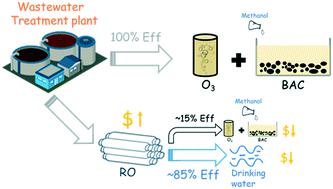当前位置:
X-MOL 学术
›
Environ. Sci.: Water Res. Technol.
›
论文详情
Our official English website, www.x-mol.net, welcomes your
feedback! (Note: you will need to create a separate account there.)
Pilot-scale ozone/biological activated carbon treatment of reverse osmosis concentrate: potential for synergism between nitrate and contaminant removal and potable reuse
Environmental Science: Water Research & Technology ( IF 3.5 ) Pub Date : 2020-03-18 , DOI: 10.1039/d0ew00013b Zhong Zhang 1, 2, 3, 4, 5 , Jacob F. King 5, 6, 7, 8 , Aleksandra Szczuka 5, 6, 7, 8 , Yi-Hsueh Chuang 5, 6, 7, 8, 9 , William A. Mitch 5, 6, 7, 8
Environmental Science: Water Research & Technology ( IF 3.5 ) Pub Date : 2020-03-18 , DOI: 10.1039/d0ew00013b Zhong Zhang 1, 2, 3, 4, 5 , Jacob F. King 5, 6, 7, 8 , Aleksandra Szczuka 5, 6, 7, 8 , Yi-Hsueh Chuang 5, 6, 7, 8, 9 , William A. Mitch 5, 6, 7, 8
Affiliation

|
With limited budgets, utilities may forego potable reuse of municipal wastewater to meet regulations requiring nitrate and contaminant removal from discharges. At 85% recovery, reverse osmosis (RO)-based potable reuse rejects contaminants into a concentrate flowrate that is 6.7-fold lower than wastewater discharges. This study evaluated the footprint and cost savings associated with treating nitrate and contaminants in RO concentrate vs. wastewater effluent. Pilot-scale ozone and biological activated carbon (BAC) treatment of RO concentrate provided design parameters needed for this comparison. Addition of 60 mg C per L methanol as a carbon source was needed to achieve complete denitrification of 70 mg N per L nitrate within a 30 min BAC empty bed contact time. Combined with pre-ozonation at 0.5 mg O3/mg DOC, this treatment removed >74% of fipronil, imidacloprid, atenolol, DEET and sulfamethoxazole. Estimates indicated that applying ozone/BAC treatment to RO concentrate rather than conventional wastewater effluent for contaminant removal prior to discharge would offset 60% of the footprint and 25% of the cost required for the RO-based potable reuse train. Considering these savings, the reuse train cost could be recouped if the product water were sold at rates below those current in southern California. These results suggest synergy rather than competition between potable reuse and contaminant removal.
中文翻译:

中试规模的反渗透浓缩液臭氧/生物活性炭处理:硝酸盐与污染物去除和饮用水再利用之间的协同潜力
在预算有限的情况下,公用事业公司可能会放弃对市政废水进行可饮用水再利用,以满足要求从排放物中去除硝酸盐和污染物的法规。回收率达到85%时,基于反渗透(RO)的便携式重复使用可将污染物排入浓缩液,其流速比废水排放低6.7倍。这项研究评估了与处理RO精矿和废水中的硝酸盐和污染物相关的占地面积和成本节省。RO精矿的中试臭氧和生物活性炭(BAC)处理提供了该比较所需的设计参数。在30分钟BAC空床接触时间内,需要每L甲醇添加60 mg C作为碳源,以实现70 mg N / L硝酸盐的完全脱氮。与0.5 mg O的预臭氧合3 / mg DOC,该处理去除了> 74%的氟虫腈,吡虫啉,阿替洛尔,DEET和磺胺甲恶唑。估计表明,对臭氧浓缩液进行臭氧/ BAC处理,而不是在排放之前去除污染物的常规废水,可以抵消60%的足迹和25%的基于RO的便携式再利用列车所需的成本。考虑到这些节省,如果产品水的销售价格低于加利福尼亚南部目前的价格,则可以弥补再利用火车的成本。这些结果表明协同作用,而不是饮用水再利用和污染物去除之间的竞争。
更新日期:2020-03-18
中文翻译:

中试规模的反渗透浓缩液臭氧/生物活性炭处理:硝酸盐与污染物去除和饮用水再利用之间的协同潜力
在预算有限的情况下,公用事业公司可能会放弃对市政废水进行可饮用水再利用,以满足要求从排放物中去除硝酸盐和污染物的法规。回收率达到85%时,基于反渗透(RO)的便携式重复使用可将污染物排入浓缩液,其流速比废水排放低6.7倍。这项研究评估了与处理RO精矿和废水中的硝酸盐和污染物相关的占地面积和成本节省。RO精矿的中试臭氧和生物活性炭(BAC)处理提供了该比较所需的设计参数。在30分钟BAC空床接触时间内,需要每L甲醇添加60 mg C作为碳源,以实现70 mg N / L硝酸盐的完全脱氮。与0.5 mg O的预臭氧合3 / mg DOC,该处理去除了> 74%的氟虫腈,吡虫啉,阿替洛尔,DEET和磺胺甲恶唑。估计表明,对臭氧浓缩液进行臭氧/ BAC处理,而不是在排放之前去除污染物的常规废水,可以抵消60%的足迹和25%的基于RO的便携式再利用列车所需的成本。考虑到这些节省,如果产品水的销售价格低于加利福尼亚南部目前的价格,则可以弥补再利用火车的成本。这些结果表明协同作用,而不是饮用水再利用和污染物去除之间的竞争。











































 京公网安备 11010802027423号
京公网安备 11010802027423号